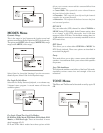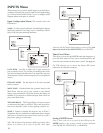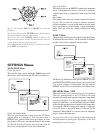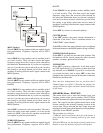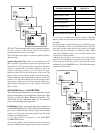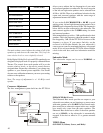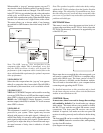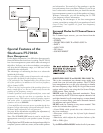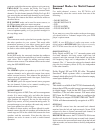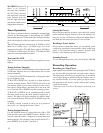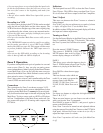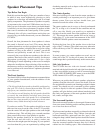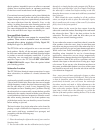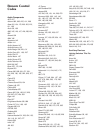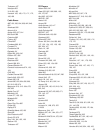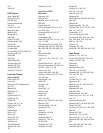43
programs, and adjust these extra options to suit your taste.
PRO LOGIC llx extends the Dolby Pro Logic II
technology by adding stereo full range surround back
channels. Use this feature instead of Dolby Pro Logic II if
you are using the surround back channels in your system.
This mode also features the Music and Movie modes as
described above.
PLII MATRIX mode can be used for mono sources, or
for FM programs with poor stereo reception.
PLII PRO LOGIC mode emulates the original standard
surround mode. It can be used for source material which
is not of optimum quality, or if you just feel nostalgic for
the way things were.
PARTY
This extra stereo mode copies the front speaker signals to
the other speakers in your system. This mode adds
tremendous presence to your stereo sources and is great
for parties and casual listening alike. The OSD menu can
be used to select which speakers are active in this mode.
JAZZ CLUB
In this DSP mode, the surrounds simulate the ambiance
caused by rear reflections and effects of a small to medium
sized venue. This is useful for adding surround sound
effects to stereo sources. The ambiance effect can be varied
using the OSD MODES menu.
DTS Neo:6
The CINEMA option can produce up to six full range,
separate channels and a subwoofer output from stereo
matrix surround sources. This enhances the playback of
sources such as surround sound video tapes, Laser Discs
and broadcast TV programs.
The MUSIC option can expand normal stereo programs
into six channels. It does so in a natural sounding way,
which enhances the listening experience.
SOURCE DIRECT
This mode bypasses all DSP, Tone, and bass management
circuits. It is stereo analog only, and offers the shortest
signal path through the PT-7010A. Only the front left and
right speakers are engaged. Do not use this mode for
digital-only sources, as it only routes the analog audio. To
prevent damage to your speakers, this mode only works if
your front speakers are set to Large.
In addition to these modes, and those offered for multi-
channel sources, the side-axis speakers will widen the front
sound stage and fill in the sound field between the front
speakers and the surrounds. Note that the side-axis
speakers are active in stereo as well as multi-channel
operation.
Surround Modes for Multi-Channel
Sources
For multi-channel sources, the PT-7010A will
automatically select the correct mode from one of the
following:
• DOLBY DIGITAL
• DOLBY DIGITAL EX
• DTS
• DTS-ES MATRIX
• DTS-ES DISCRETE
If you want to try one of the modes on the previous page,
you should select a 2-channel output from your DVD
player’s options menu.
NOTE: In your DVD player’s audio setup menu, set the
digital output to BITSTREAM. If this is not set correctly,
the PT-7010A cannot decode the digital information.
DOLBY DIGITAL 5.1
Dolby Digital and DTS are “5.1” surround systems with
five main channels: left front, center, right front, left
surround, and right surround. Each channel can play the
full frequency range and is independent of the other
channels. The “.1” denotes the subwoofer channel which
plays the low frequency effects (LFE), also independent
of the other channels.
Dolby Digital EX and DTS ES offer “Extended
Surround.” Both systems offer a surround back
channel which effectively fills in the otherwise empty
sound space behind you.
DTS (5.1)
This mode is available if the PT-7010A automatically
detects that a DTS encoded source is present at one of
its digital inputs. Look for the DTS Logo on DVDs,
Laserdiscs, CDs and other sources. You must select
DTS from the DVD options menu to configure the
DVD player to output a DTS BITSTREAM. The PT-
7010A will then automatically recognize it as DTS.
DTSES(6.1)
All DTS-ES sources have the surround back channel
matrixed into the left and right surrounds. Newer DVD
releases also have a discrete surround back channel, in
addition to the same information matrixed.
DISCRETE ES sources: the PT-7010A DTS-ES discrete
decoder will decode the discrete surround back channel.
It also removes the surround back matrix from the left and
right surrounds, and restores them to be fully independent
channels.



